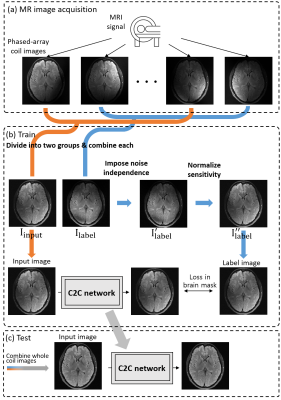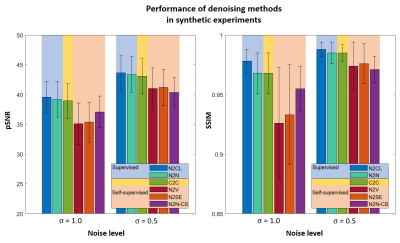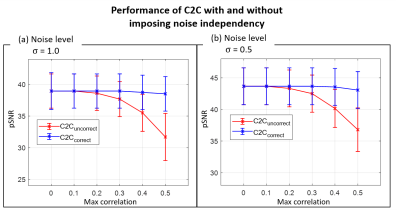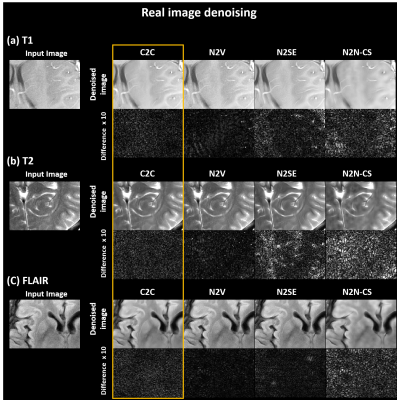1157
Coil to Coil: Self-supervised denoising using phased-array coil images1Department of Electrical and Computer Engineering, Seoul National University, Seoul, Korea, Republic of, 2Ulsan National Institute of Science and Technology, Ulsan, Korea, Republic of
Synopsis
A self-supervised learning framework, Coil to Coil (C2C), is proposed. This method generates two noise-corrupted images from single phased-array coil data to train a denoising network and, therefore, requires no clean image nor acquisition of a pair of noisy images. The two images are processed to have the same signals and independent noises, satisfying conditions for the noise to noise algorithm, which requires paired noise-corrupted images. C2C shows the best performance among popular self-supervised denoising methods in both real and synthetic noised images, revealing little or no structure in the noise map.
Introduction
For MR image denoising, various deep learning methods were proposed, showing promising results1-5. However, these methods either require clean images, which are difficult to obtain, or redundancy from a specific MR sequence (e.g., multiple b-values in diffusion imaging4 or time-course in dynamic imaging5), limiting their applications. Recently, self-supervised learning methods such as noise to noise (N2N)6 showed promising performance. The method does not require a clean image but utilizes paired noise-corrupted images for training, improving requirements for training data. However, obtaining two noise-corrupted images in MR is still difficult, involving additional scans in most studies. In this study, we propose a new method, that does not require clean images nor acquisition of the paired noise-corrupted images. Our method generates a paired noise-corrupted images from single phased-array coil data and utilizes the pair for network training, requiring only raw multi-channel data. For inference, the method can input phased-array coil data or coil-combined image (e.g., DICOM images), enabling a wide application of the method. This new method is referred to as Coil to Coil (C2C) and is evaluated with synthetic data and applied to real data.Methods
[Coil to Coil] In C2C, paired noise-corrupted images are generated from single phased-array coil data and then, the N2N algorithm6 is utilized to train a network. For N2N, the two noise-corrupted images need to satisfy three conditions: Firstly, two noise terms of the two images are independent. Secondly, the clean signals of the two images are the same. Lastly, the expectations of the noise terms are zero. C2C processes phased-array coil data to satisfy these conditions.In MRI, ith coil image ($$$y_i$$$) can be formulated as $$$y_i=s_ix+n_i$$$ where $$$s_i$$$ is ith coil sensitivity and $$$n_i$$$ is noise $$$(i\in C=[1...c])$$$. To generate two noise-corrupted images, the coil images are randomly divided into two groups of equal numbers. Then, each group images are combined and labeled as $$$I_{input}$$$ and $$$I_{label}$$$ : $$$I_{input}=|\sum_js_j^Hy_j|$$$ and $$$I_{input}=|\sum_js_k^Hy_k|$$$ where $$$j\cup k=C$$$ and $$$j\cap k=0$$$. To impose independence in noise between the two combined images, generalized least-square was adopted voxel-wisely:$$\begin{bmatrix}I_{input}'\\I_{label}'\end{bmatrix}=\begin{bmatrix}1 & 0 \\\alpha & \beta \end{bmatrix}\begin{bmatrix}I_{input}\\I_{label}\end{bmatrix}$$ $$where, \alpha=\frac{-\sigma_{jk}}{\sqrt{\sigma_{jj}\sigma_{kk} - \sigma_{jk}^2}}, \beta=\frac{\sigma_{jj}}{\sqrt{\sigma_{jj}\sigma_{kk} - \sigma_{jk}^2}}$$ $$$\sigma_{jj}$$$, $$$\sigma_{kk}$$$, and $$$\sigma_{jk}$$$ were $$$\sum_j|s_j^H|^2var(N_j)$$$, $$$\sum_j|s_k^H|^2var(N_k)$$$, and $$$\sum_j|s_j^H||s_k^H|cov(N_j,N_k)$$$, respectively with $$$N_j$$$ and $$$N_k$$$ are noise in the input and label images, respectively. The noise variances and covariances were estimated using 400 pixels in the background and scaled by (2- $$$\pi$$$/2)-1, correcting for the Rayleigh property. To normalize the sensitivity, the coil sensitivity of the two groups ($$$S_j=|\sum_js_j^H|$$$ and $$$S_k'=\alpha|\sum_ks_k^H| + \beta|\sum_js_j^H|$$$) are calculated in each voxel and the ratio ($$$S_j/S_k'$$$) was multiplied to $$$I_{label}'$$$ ($$$I_{label}''=(S_j/S_k')I_{label}'$$$). The condition of zero expectation noise is believed to be corrected for reasonably high SNR images. To avoid errors from the background which has Rayleigh distribution, the loss function was calculated with a brain mask. The loss function was defined as $$$E_{\in brainmask}|S_k'f_\theta(I_{input})-S_jI_{label}'|$$$. When testing the trained network (Fig. 1c), all coil images were combined and inferenced. Alternatively, we tested two grouped, each denoised, and combined results, revealing similar outcomes.
[Denoising of synthetic noise added images] Experiments were performed by adding synthetic noise to MRI images. FastMRI challenge dataset7 was utilized for training and test (34341 and 8284 slices, respectively; 3 contrasts). The sensitivity maps were estimated using ESPIRiT8. Two noise levels ($$$\sigma$$$) of 1.0 and 0.5 were tested. Noise correlation between any two coils was randomly chosen from 0 to 0.2. For the neural network, DnCNN9 and U-net10 were tested. To compare the performance of C2C, deep learning-based denoising methods (supervised: Noise to Clean (N2CL)11, and N2N6; self-supervised methods: Noise to Void (N2V)12, Noise to Self (N2SE)13, and a compressed sensing-based method (N2N-CS)6) were applied.
[Denosing of real images] Experiments were performed to denoise real images. A network for real noise denoising was trained and tested with the same data as before but with no additional noise. Since no clean images exist, C2C was compared only with self-supervised methods (N2V, N2Se, and N2N-CS).
Results
When tested, C2C successfully denoised the synthetic noise (Fig. 2) and real noise (Fig. 5; DnCNN results hereafter; U-net slightly underperforming). When applied to the synthetic noise added images, the C2C images show high-quality images that match to the original images with no or little structure-dependent errors in the difference images (all three contrasts). The quantitative metrics (Fig. 3) outperformed those of the other self-supervised methods, reporting comparable results to those of the supervised methods. When C2C was tested with and without noise independence processing (Fig. 4), the results show that the processing improves the robustness from noise correlation. In denoising real images (Fig. 5), C2C successfully improves all the images, revealing little or no structure-dependent signals in the noise maps.Conclusion & Discussion
In this study, we proposed a self-supervised image denoising method, C2C, which generated paired noise-corrupted images from phased-array coil images to train a deep neural network. This method only requires multichannel data for network training and, therefore, can be easily utilized for other scans. C2C outperformed the other self-supervised methods and showed comparable results to the supervised methods. The method can be applied to DICOM images, enabling a wide use of the method.Acknowledgements
This work has been supported by the National Research Foundation of Korea(NRF) grant funded by the Korea government(MSIT)(No. 2021M3E5D2A01024795) and NRF-2021R1A2B5B03002783.References
[1] L. Gondara, "Medical image denoising using convolutional denoising autoencoders," in 2016 IEEE 16th international conference on data mining workshops (ICDMW), 2016: IEEE, pp. 241-246.
[2] X. Xu et al., "Noise Estimation-based Method for MRI Denoising with Discriminative Perceptual Architecture," in 2020 International Conferences on Internet of Things (iThings) and IEEE Green Computing and Communications (GreenCom) and IEEE Cyber, Physical and Social Computing (CPSCom) and IEEE Smart Data (SmartData) and IEEE Congress on Cybermatics (Cybermatics), 2020: IEEE, pp. 469-473.
[3] M. Kidoh et al., "Deep learning based noise reduction for brain MR imaging: tests on phantoms and healthy volunteers," Magnetic Resonance in Medical Sciences, vol. 19, no. 3, p. 195, 2020.
[4] S. Fadnavis, J. Batson, and E. Garyfallidis, "Patch2Self: denoising diffusion MRI with self-supervised learning," arXiv preprint arXiv:2011.01355, 2020.
[5] J. Xu and E. Adalsteinsson, "Deformed2Self: Self-Supervised Denoising for Dynamic Medical Imaging," arXiv preprint arXiv:2106.12175, 2021.
[6] J. Lehtinen et al., "Noise2noise: Learning image restoration without clean data," arXiv preprint arXiv:1803.04189, 2018.
[7] J. Zbontar et al., "fastMRI: An open dataset and benchmarks for accelerated MRI," arXiv preprint arXiv:1811.08839, 2018.
[8] M. Uecker et al., "ESPIRiT—an eigenvalue approach to autocalibrating parallel MRI: where SENSE meets GRAPPA," Magnetic resonance in medicine, vol. 71, no. 3, pp. 990-1001, 2014.
[9] K. Zhang, W. Zuo, Y. Chen, D. Meng, and L. Zhang, "Beyond a gaussian denoiser: Residual learning of deep cnn for image denoising," IEEE transactions on image processing, vol. 26, no. 7, pp. 3142-3155, 2017.
[10] O. Ronneberger, P. Fischer, and T. Brox, "U-net: Convolutional networks for biomedical image segmentation," in International Conference on Medical image computing and computer-assisted intervention, 2015: Springer, pp. 234-241.
[11] V. Jain and S. Seung, "Natural image denoising with convolutional networks," Advances in neural information processing systems, vol. 21, 2008.
[12] A. Krull, T.-O. Buchholz, and F. Jug, "Noise2void-learning denoising from single noisy images," in Proceedings of the IEEE/CVF Conference on Computer Vision and Pattern Recognition, 2019, pp. 2129-2137.
[13] J. Batson and L. Royer, "Noise2self: Blind denoising by self-supervision," in International Conference on Machine Learning, 2019: PMLR, pp. 524-533.
Figures




